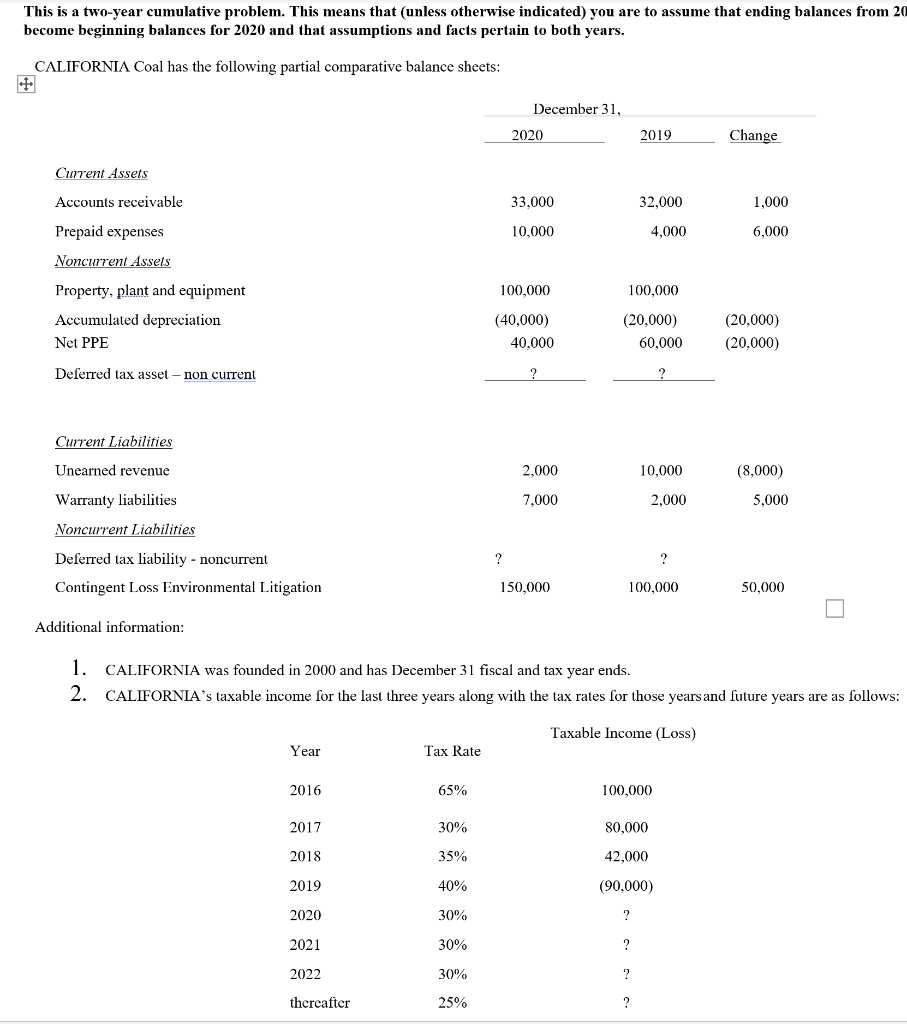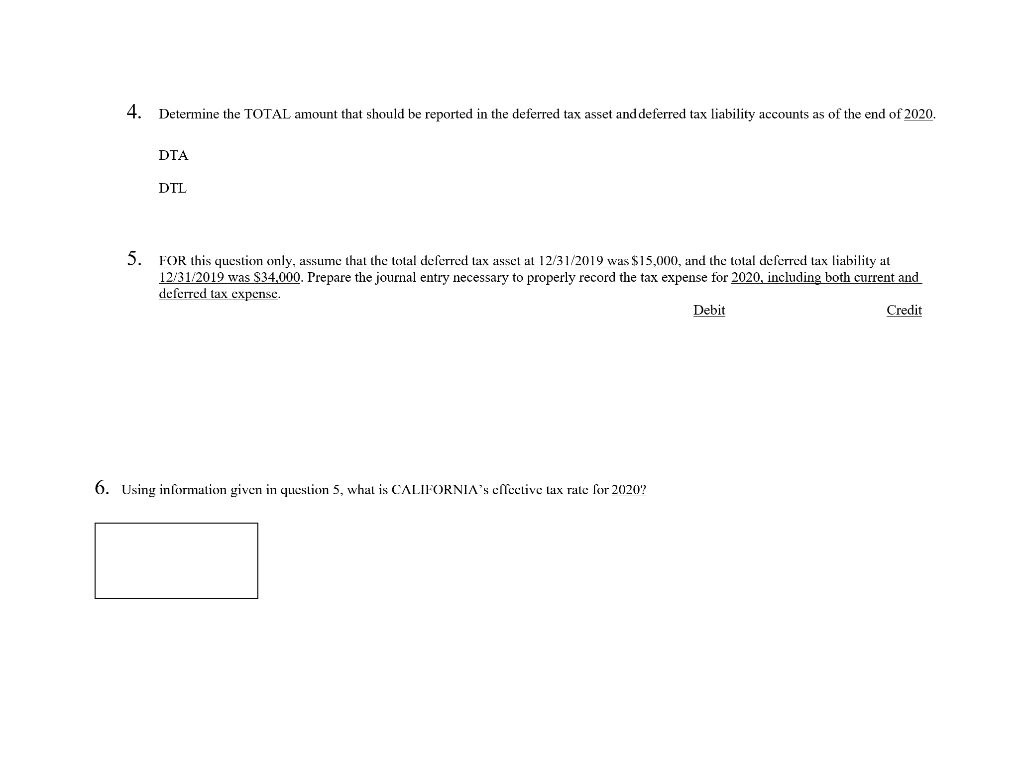




This is a two-year cumulative problem. This means that (unless otherwise indicated) you are to assume that ending balances from 20 become beginning balances for 2020 and that assumptions and facts pertain to both years. CALIFORNIA Coal has the following partial comparative balance sheets: December 31, 2020 2019 Change Current Assets Accounts receivable 33,000 32,000 1,000 10,000 4,000 6,000 Prepaid expenses Noncurrent Assets Property, plant and equipment Accumulated depreciation Net PPE 100,000 100,000 (40,000) 40.000 (20.000) 60,000 (20,000) (20,000) Deferred tax asset -non current ? ? Current Liabilities Unearned revenue 2,000 10,000 (8,000) Warranty liabilities 7,000 2,000 5,000 Noncurrent Liabilities ? ? Deferred tax liability - noncurrent Contingent Loss Environmental Litigation 150.000 100,000 50,000 Additional information: 1. CALIFORNIA was founded in 2000 and has December 31 fiscal and tax year ends. 2. CALIFORNIA's taxable income for the last three years along with the tax rates for those years and future years are as follows: Taxable Income (Loss) Year Tax Rate 2016 65% 100,000 2017 30% 80,000 2018 35% 42,000 2019 40% (90.000) 2020 30% ? 2021 30% ? 2022 30% ? thereafter 25% ? CALIFORNIA wants to use the 2019 taxable loss as soon as possible to offset past and future income. At the time the operating loss was incurred, CALIFORNIA's expected taxable income was $40,000 in 2020, $20,000 in 2021 and $50,000 in 2022. 3. CALIFORNIA is on a cash basis for tax purposes except for fixed assets. For lax purposes, fixed assets are capitalized and depreciated using MACRS. In 2019 and 2020 the company accrued liabilities related to a lawsuit resulting from the release of coal ash slurry into a stream near its strip mine in Tennessee. These amounts are not deductible for tax purposes until paid. CALIFORNIA plans to fight the lawsuit until appeals are exhausted. Because of this, the company does not expect to make payments related the lawsuit until 2023 at the earliest. 4. The company owns equipment purchased on January 1, 2019 for $100,000. For book purposes, these assets are depreciated using straight-line depreciation over a five-year life with no salvage value. For tax purposes, fixed assets are depreciated under MACRS. 5. In 2020, CALIFORNIA recorded pre-tax book income of $60,000. This included $8,000 of tax- free interest on municipal bonds and $5,000 of fines paid for violating environmental laws. 6. The following schedule shows the difference between tax depreciation and book depreciation for each year of the life of the equipment. 2019 2020 2021 2022 2023 33,000 44,000 15,000 8,000 0 Tax Depreciation Accounting Depreciation Difference (Tax Book) 20,000 13,000 20,000 24,000 20,000 (5,000) 20,000 (12,000) 20,000 (20,000) Required: 1. As of December 31, 2019 compute the following two amounts, assuming that an election is made to carry back any operating losses to the fullest extent possible under the law: a. Taxes receivable due to Net Operating Loss Carryback, if any b. Deferred tax asset due to Net Operating Loss Carryforward, if any 4. Determine the TOTAL amount that should be reported in the deferred tax asset and deferred tax liability accounts as of the end of 2020. DTA DTL 5. FOR this question only, assume that the total deferred tax asset at 12/31/2019 was $15,000, and the total deferred tax liability at 12/31/2019 was $34,000. Prepare the journal entry necessary to properly record the tax expense for 2020, including both current and deferred tax expense. Debit Credit 6. Using information given in question 5, what is CALIFORNIA's cleclive tax rate for 2020? This is a two-year cumulative problem. This means that (unless otherwise indicated) you are to assume that ending balances from 20 become beginning balances for 2020 and that assumptions and facts pertain to both years. CALIFORNIA Coal has the following partial comparative balance sheets: December 31, 2020 2019 Change Current Assets Accounts receivable 33,000 32,000 1,000 10,000 4,000 6,000 Prepaid expenses Noncurrent Assets Property, plant and equipment Accumulated depreciation Net PPE 100,000 100,000 (40,000) 40.000 (20.000) 60,000 (20,000) (20,000) Deferred tax asset -non current ? ? Current Liabilities Unearned revenue 2,000 10,000 (8,000) Warranty liabilities 7,000 2,000 5,000 Noncurrent Liabilities ? ? Deferred tax liability - noncurrent Contingent Loss Environmental Litigation 150.000 100,000 50,000 Additional information: 1. CALIFORNIA was founded in 2000 and has December 31 fiscal and tax year ends. 2. CALIFORNIA's taxable income for the last three years along with the tax rates for those years and future years are as follows: Taxable Income (Loss) Year Tax Rate 2016 65% 100,000 2017 30% 80,000 2018 35% 42,000 2019 40% (90.000) 2020 30% ? 2021 30% ? 2022 30% ? thereafter 25% ? CALIFORNIA wants to use the 2019 taxable loss as soon as possible to offset past and future income. At the time the operating loss was incurred, CALIFORNIA's expected taxable income was $40,000 in 2020, $20,000 in 2021 and $50,000 in 2022. 3. CALIFORNIA is on a cash basis for tax purposes except for fixed assets. For lax purposes, fixed assets are capitalized and depreciated using MACRS. In 2019 and 2020 the company accrued liabilities related to a lawsuit resulting from the release of coal ash slurry into a stream near its strip mine in Tennessee. These amounts are not deductible for tax purposes until paid. CALIFORNIA plans to fight the lawsuit until appeals are exhausted. Because of this, the company does not expect to make payments related the lawsuit until 2023 at the earliest. 4. The company owns equipment purchased on January 1, 2019 for $100,000. For book purposes, these assets are depreciated using straight-line depreciation over a five-year life with no salvage value. For tax purposes, fixed assets are depreciated under MACRS. 5. In 2020, CALIFORNIA recorded pre-tax book income of $60,000. This included $8,000 of tax- free interest on municipal bonds and $5,000 of fines paid for violating environmental laws. 6. The following schedule shows the difference between tax depreciation and book depreciation for each year of the life of the equipment. 2019 2020 2021 2022 2023 33,000 44,000 15,000 8,000 0 Tax Depreciation Accounting Depreciation Difference (Tax Book) 20,000 13,000 20,000 24,000 20,000 (5,000) 20,000 (12,000) 20,000 (20,000) Required: 1. As of December 31, 2019 compute the following two amounts, assuming that an election is made to carry back any operating losses to the fullest extent possible under the law: a. Taxes receivable due to Net Operating Loss Carryback, if any b. Deferred tax asset due to Net Operating Loss Carryforward, if any 4. Determine the TOTAL amount that should be reported in the deferred tax asset and deferred tax liability accounts as of the end of 2020. DTA DTL 5. FOR this question only, assume that the total deferred tax asset at 12/31/2019 was $15,000, and the total deferred tax liability at 12/31/2019 was $34,000. Prepare the journal entry necessary to properly record the tax expense for 2020, including both current and deferred tax expense. Debit Credit 6. Using information given in question 5, what is CALIFORNIA's cleclive tax rate for 2020











